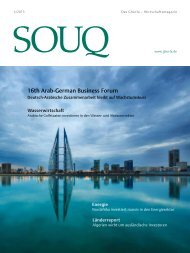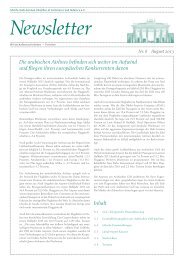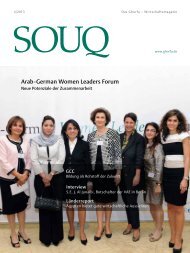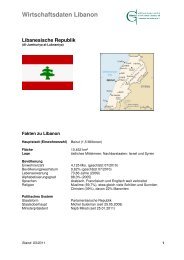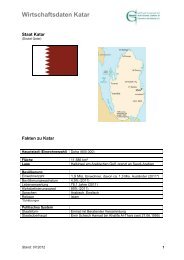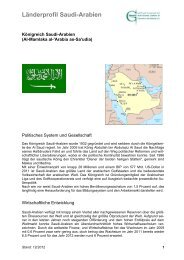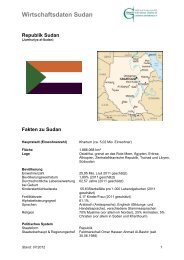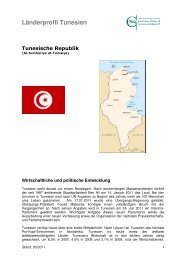Saudi-Arabien Wirtschaftshandbuch Saudi Arabia Business ... - Ghorfa
Saudi-Arabien Wirtschaftshandbuch Saudi Arabia Business ... - Ghorfa
Saudi-Arabien Wirtschaftshandbuch Saudi Arabia Business ... - Ghorfa
Sie wollen auch ein ePaper? Erhöhen Sie die Reichweite Ihrer Titel.
YUMPU macht aus Druck-PDFs automatisch weboptimierte ePaper, die Google liebt.
Englischen nicht law sondern regulations. Dies ist zwar<br />
eher akademischer denn praktischer Natur, hat jedoch<br />
zur Folge, dass diese Vorschriften auch immer Gegenstand<br />
eines islamischen ordre public sein können.<br />
Ab den 1960er Jahren sind zahlreiche Kodifikationen<br />
im Bereich des Wirtschaftsrechts erfolgt, um den Anforderungen<br />
einer modernen Gesellschaft gerecht zu<br />
werden. Hierbei ist anzumerken, dass alle diese Kodifikationen<br />
in Übereinstimmung zu den Grundprinzipien<br />
islamischen Rechts stehen. Zwischen den Jahren 2000<br />
bis 2005 wurden im Hinblick auf den Ende des Jahres<br />
2005 erfolgten Beitritt <strong>Saudi</strong>-<strong>Arabien</strong>s zur Welthandelssorganisation<br />
WTO verschiedene Gesetze wesentlich<br />
überarbeitet.<br />
–––––––––––––––––––––––––––––––<br />
the leGAl SyStem In SAudI ArAbIA<br />
The law of the Kingdom of <strong>Saudi</strong> <strong>Arabia</strong> is not a codified<br />
law but Islamic law which is based on the following four<br />
sources:<br />
– koran,<br />
– Sunna, i.e. the passed down sayings, actions and<br />
sufferances of the prophet as a model for correct<br />
conduct,<br />
– ijma c , i.e. the consensus of the Islamic community<br />
established by the recognised jurists and<br />
– qiyas, i.e. the legal system developed by the Islamic<br />
law schools based on legal analogy.<br />
The Central Arab region follows the Hanbalitic legal<br />
school, in <strong>Saudi</strong> <strong>Arabia</strong> marked by Mohammad Ibn<br />
Abdul-Wahab Al-Shaikh (1703-1792), who exerted<br />
enormous religious influence in his life in the 18th<br />
century. He followed the teachings of Ibn Taymiyya<br />
(728AH/1328AD) from Damascus. Other legal schools<br />
in the Sunnite Islam are the Malicites, primarily in<br />
Maghreb, the Hanafites in Egypt and on the Levant, and<br />
the Shafi c iten, also in Egypt.<br />
<strong>Saudi</strong> <strong>Arabia</strong> as a territorial state is traditionally subject<br />
to various legal influences. On the one hand the Hijaz,<br />
the west coast of <strong>Arabia</strong>, was influenced by the Ottoman<br />
Empire and therefore the Mejelle (Majalat Al-Ahkam<br />
Al-Adliyah), a codification of the contract and obligation<br />
law that can be assigned to the Hanafite legal school<br />
and the civil procedure law. This came into effect in the<br />
Ottoman Empire in 1877.<br />
rechTliche rAhMenBeDinGunGen – – underlyInG leGAl condItIonS<br />
On the other, a codified civil law system came over from<br />
Egypt. Here, a civil law book came into effect in 1948; this<br />
book was primarily drafted by the famous Egyptian jurist<br />
Abdel Razzaq As-Sanhuri. He was subsequently commissioned<br />
to draft civil law books for a variety of states such<br />
as e.g. Iraq (1951), Libya (1953), Kuwait (1859), Sudan<br />
and Bahrain (1961).<br />
However this did not happen in <strong>Saudi</strong> <strong>Arabia</strong>.<br />
The main focus here was to unify the Kingdom and uphold<br />
traditions, free of colonial influences. It is probable<br />
that in 1927 King Abdul Aziz tried to codify the Islamic<br />
law based the Hanbalitic interpretation by Ibn Taymiyyas.<br />
However, the Hanbalitic jurists were opposed to this<br />
and <strong>Saudi</strong> <strong>Arabia</strong>n regulations dating from the years<br />
1928 and 1930 stipulate that the judges must use the recognised<br />
sources of the Hanbalitic legal school when deciding<br />
on their judgement.<br />
There was also a further attempt to codify the legal principles<br />
of the Hanbalitic legal school. This work by Majallat<br />
Al-Ahkam Ash-Shariya von Al-Qari was published in<br />
1401 H (1981) in Jeddah. However, it never reached the<br />
status of a law, but simply served the jurists as a tool when<br />
passing judgment.<br />
Something similar happened at the start of the 1920s<br />
when attempts were made to give the then Kingdom of<br />
Nejd and Hijaz a constitution, which was ultimately not<br />
extended. Also, a Sharia civil procedure law, which was<br />
published in the official gazette (the Um Al-Qura) in<br />
1410 H (1992), did not actually come into effect.<br />
The laws in <strong>Saudi</strong> <strong>Arabia</strong> are not actually laws as such<br />
because no laws created by man may serve as laws next<br />
to the religious law. This is apparent in the Arabic<br />
choice of words that is only found in <strong>Saudi</strong> <strong>Arabia</strong>.<br />
Legal stipulations are not called qanun, but nizam,<br />
i.e. regulations and not laws. This may seem purely<br />
academic but does have the consequence that it is<br />
possible that these regulations can always be the object<br />
of an Islamic ordre public.<br />
From the 1960s onwards, numerous codifications relating<br />
to economic law have been passed to meet the needs<br />
of a modern society. It should be noted here that all<br />
these codifications comply with the basic principles of<br />
Islamic law. Between the years 2000 and 2005, important<br />
laws were revised in preparation for <strong>Saudi</strong> <strong>Arabia</strong>’s<br />
entry to the World Trade Organisation (WTO) at the<br />
end of 2005.<br />
97



